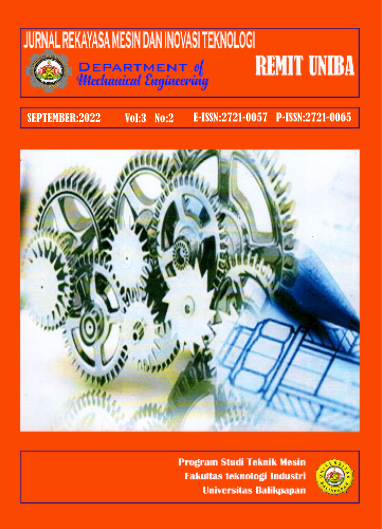Comparative Analysis of Tensile Strength Result of 3D Printing With ABS And Nylon-Based Filament
ABS And Nylon-Based Filament
Keywords:
ABS and nylon filament, 3D printing, tensile strengthAbstract
The purpose of this study was to find the average stress on a specimen made using a 3D Printer with ABS and nylon filaments, compare the results of the tensile strength of the two types of specimens, identify the type of fracture in the specimen, and compare the results of the tensile test of the two types of specimens with the standard. tensile strength. This study used test specimens made using a 3d printer with 3 specimens of ABS filament and 3 specimens of nylon. The test specimens were made according to the ASTM D 638-02 standard with the loading given to the specimens of 5 mm/minute for ABS, and 50 mm/minute for nylon. From this research, it is known that the highest average tensile strength value in ABS specimen is 29.52 Mpa, and in nylon specimen is 24.73 Mpa. The results of the fractures obtained in this study are that brittle fractures are found in ABS specimens, and for ductile fractures are found in nylon specimens. From the comparison results on the two specimens with the minimum standard of tensile strength, the minimum tensile strength of the ABS specimen is 28 MPa, so the results obtained indicate that the ABS specimen is included in the standard so that it can be used for manufacturing spare parts. Meanwhile, for nylon specimens, the minimum tensile strength is 38.6 MPa, so the tensile test results on nylon specimens are not included in the standard so that they are not suitable for use in manufacturing.
References
Lubis Sobron, Sofyan Djamil, dan Yolanda, “Pengaruh Orientasi Objek Pada Proses 3D Printing Bahan Polimer PLA dan ABS Terhadap Kekuatan Tarik dan Ketelitian Dimensi Produk,” Sinergi, vol. 20, pp. 27–35, 2016.
Pratama Wahyudi, Hasdiansah, dan Husman, “Optimasi Parameter Proses 3D Printing Terhadap Kuat Tarik Material Filamen PLA + Menggunakan Metode Taguchi,” SJoME, vol. 3, no. 1, Aug. 2021.
Finali Asmar, Fauzi Hanafi, dan Rochmad Eko, “Analisis Variasi Pattern 3D Printing terhadap
Kekuatan Tarik,” J-Proteksion, vol. 5, no. 1, pp. 16–19, Aug. 2020.
Gouldsen Colin dan Paul Blake, “Investment Casting Using FDM / ABS Rapid Prototype Patterns,” Rapid ToolworX Stratasys Inc, vol. 63, pp. 1–35, 1998.
P. Jain dan A. M. Kuthe, “Feasibility study of manufacturing using rapid prototyping: FDM approach,” Procedia Engineering, vol. 63, pp. 4–11, 2013, doi: 10.1016/j.proeng.2013.08.275.
G. Wypych, Handbook of Polymers, vol. 5, no. 2. 2016. doi: 10.3390/polym5010225.
Askeland Donald R. dan Pradeep P. Fulay, Essentials of Materials Science and Engineering 1, 2nd ed. Boston, USA: PWS Engineering, 1995.
CALLISTER WILLIAM D. CALLISTER dan DAVID G. RETHWISCH, Materials Science and Engineering, 10th ed., vol. 12. Hoboken, New Jersey: Wiley, 2018.
Rudi Arya dan Abdoel Ghania, Buku Pelatihan Solidworks, vol. 1. Medan: Universitas Muhammadiyah , 2019.
J. R. Davis, “ASTM D 638-02,” ASTM, pp. 1–13, 2004, [Online]. Available: www.asminternational.org. [Diakses 30 Mei 2022]
J. R. Davis, “ASTM D 4673,” ASTM, pp. 1–7, 2002, [Online]. Available: www.asminternational.org. [Diakses 24 Juli 2022]
J. R. Davis, “ASTM D 4066-13,” ASTM, pp. 1–18, 2013, [Online]. Available: www.asminternational.org. [Diakses 24 Juli 2022]


